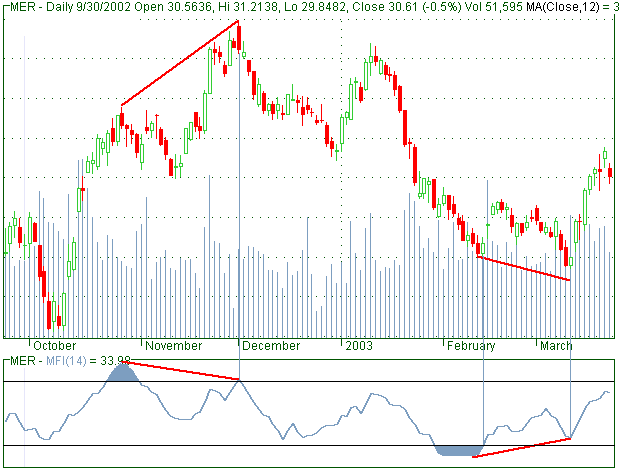|
New Page 2
Money flow
Index
Money flow in technical analysis is typical price multiplied by volume, a
kind of approximation to the dollar value of a day's trading.
Money flow index (MFI) is an oscillator calculated over an N-day period,
ranging from 0 to 100, showing money flow on up days as a percentage of
the total of up and down days.
Calculations
The calculations are as follows. The typical price for each day is the
average of high, low and close,
Typical Price = ( (Day High + Day
Low + Day Close) / 3)
Money flow is the product of typical price and the volume on that day.
Money Flow = (Typical Price) x
(Volume)
Totals of the money flow amounts over the given N days are then formed.
Positive money flow is the total for those days where the typical price is
higher than the previous day's typical price, and negative money flow
where below. (If typical price is unchanged then that day is discarded.) A
money ratio is then formed
Money Ratio = (Positive Money Flow /
Negative Money Flow)
From which a money flow index ranging from 0 to 100 is formed,
Money Flow Index = 100 - (100 / (1 +
Money Ratio))
This can be expressed equivalently as follows. This form makes it clearer
how the MFI is a percentage,
Money Flow
Index = 100 x Positive Money Flow / (Positive Money Flow + Negative Money
Flow)

How
To Use
MFI is used as an oscillator. A value of 80 is generally considered
overbought, or a value of 20 oversold. Divergences between MFI and price
action are also considered significant, for instance if price makes a new
rally high but the MFI high is less than its previous high then that may
indicate a weak advance, likely to reverse.
It will be noted the MFI is constructed in a similar fashion to the
relative strength index. Both look at up days against total up plus down
days, but the scale, ie. what is accumulated on those days, is volume (or
dollar volume approximation rather) for the MFI, as opposed to price
change amounts for the RSI.
It's important to be clear about what "money flow" means. It refers to
dollar volume, ie. the total value of shares traded. Sometimes finance
commentators speak of money "flowing into" a stock, but that expression
only refers to the enthusiasm of buyers (obviously there's never any net
money in or out, because for every buyer there's a seller of the same
amount).
For the purposes of the MFI, "money flow", ie. dollar volume, on an up day
is taken to represent the enthusiastism of buyers, and on a down day to
represent the enthusiasm of sellers. An excessive proportion in one
direction or the other is interpreted as an extreme, likely to result in a
price reversal.
|
